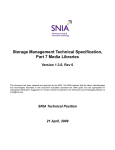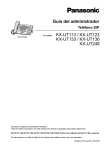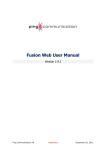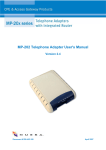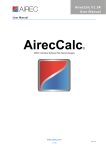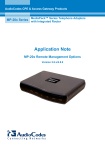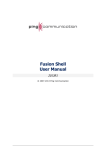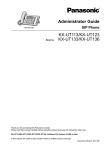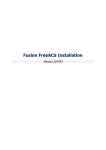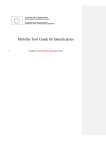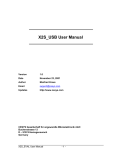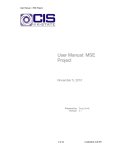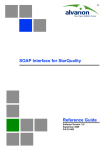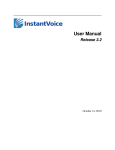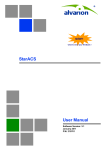Download Fusion Web Services User Manual
Transcript
Fusion Web Services User Manual 2013R1 © 2007-2012 Ping Communication Ping Communication Restricted 1 March 2013 Table of Contents Fusion Web Services User Manual............................................................................1 2013R1................................................................................................................1 1 Document Introduction.........................................................................................4 1.1 Document Purpose.........................................................................................4 1.2 Document Audience........................................................................................4 1.3 Document History.......................................................................................... 4 1.4 Acronyms and Abbreviations............................................................................4 2 Introduction........................................................................................................6 3 General stuff.......................................................................................................7 3.1 Login............................................................................................................7 3.2 Unit Type/Profile............................................................................................7 3.3 Unit Id..........................................................................................................7 3.4 Serial Number – A unique value.......................................................................8 3.5 Parameter.....................................................................................................8 3.6 Keyroot.........................................................................................................9 3.7 Exceptions.................................................................................................... 9 3.8 Color codes................................................................................................... 9 3.9 XML..............................................................................................................9 4 addOrChangeUnit – “add” use case......................................................................10 4.1 use case 1: add Unit, known Unit id + secret...................................................11 5 addOrChangeUnit – “change” use cases................................................................12 5.1 use case 2: change a Unit, known Unit id........................................................13 5.2 use case 3: change a Unit, unknown Unit id.....................................................14 6 deleteUnit.........................................................................................................15 6.1 use case 1: delete a Unit, known Unit id..........................................................15 6.2 use case 2: delete a Unit, unknown Unit id......................................................15 7 getUnits............................................................................................................16 7.1 Introduction.................................................................................................16 7.1.1 Searching for one single Unit....................................................................16 7.1.2 Searching for many Units.........................................................................16 7.1.3 Preference............................................................................................. 17 7.1.4 Return limit............................................................................................17 7.1.5 Partial searches......................................................................................17 7.1.6 The result set.........................................................................................17 7.1.7 Miscellaneous.........................................................................................18 7.2 use case 1: search for a single Unit, known Unit id...........................................19 7.3 use case 2: search for a Unit(s), using a parameter value................................. 20 7.4 use case 3: search for many Units, using various criteria.................................. 22 8 getUnitIds.........................................................................................................24 9 addOrChangeUnittype........................................................................................ 25 10 deleteUnittype.................................................................................................26 11 getUnittypes....................................................................................................27 12 addOrChangeProfile..........................................................................................28 13 deleteProfile.................................................................................................... 29 14 getProfiles.......................................................................................................30 15 Redirection/Troubleshooting..............................................................................31 16 Appendix.........................................................................................................32 16.1 Add/Change unit (chapter 4.1/5.1)...............................................................32 16.2 Change unit (chapter 5.2)........................................................................... 33 16.3 Search using unit-id (chapter 7.2)................................................................ 33 16.4 Search using unique value (chapter 7.3)....................................................... 34 16.5 Search using parameter-search (chapter 7.4)................................................ 34 1 Document Introduction 1.1 Document Purpose The purpose of the document is to explain the Fusion Web Services interface. 1.2 Document Audience Developers of Fusion Web Service Clients and Fusion Administrators. 1.3 Document History Version Editor Date Changes 1.0.5 M. Simonsen 23-Mar-09 Initial public version. 1.0.6 M. Simonsen 29-Sep-09 Revised edition, added info about SSL connection + password 1.0.7 M. Simonsen 01-Oct-09 Revised edition 1.1.0 M. Simonsen 19-Oct-09 Complete rework of documentation. Added getUnits() and deleteUnit(), many changes to existing service 1.2.0 M. Simonsen 11-May-10 Added 7 new methods for manipulating Unit Type & Profile, and to return all unitIds for a set of search criteria. User/permissions are now integrated into the services. 1.3.1 M. Simonsen 24-Jun-11 Changed the getUnits-services to allow for more complex searches. Added some restrictions on the usage of unit-id search. Documentation updated. 1.3.1 M. Simonsen 21-Sep-11 Renaming from xAPS to Fusion 1.3.2 M. Simonsen 14-Dec-11 Updating to 2012R1, removed last chapter (SSL tips) 1.4.3 M. Simonsen 04-Apr-12 Revised edition, removed OPPreferences, rewrote some passages, added XML-appendix, improved chapter 3 (General stuff) 2013R1 M. Simonsen 01-Mar-13 Updated to latest version 1.4 Acronyms and Abbreviations Acronym Explanation ACS Auto Configuration Server. APS Automatic Provisioning System. Fusion Owera's eXtensible APS with advanced features such as Service Windows, Job Control and Smart Groups. 4 Fusion Module The Fusion consists of several independently running Modules. The Modules may run on separate hosts in the network. North Side Common term describing the part of the Fusion which includes all Fusion Modules that provide management interfaces. South Side Common term describing the part of the Fusion which includes all Fusion Modules that provide CPE communication protocols. Core Common term describing the part of the Fusion which includes all Fusion Modules that provide neither management interfaces nor CPE communication protocols. CPE Customer Premises Equipment. Used in this document to refer to a single physical device. Same as the term “Device”. Fusion Administrator Employee of a Hosting Provider managing network infrastructure. Typically the person deploying, configuring and running the Fusion. Fusion Operator Employee of a Hosting/Virtual Provider managing the provisioned deployment of CPEs through the Fusion Web Interface. Fusion Data Model How the Fusion determines which Parameter values and other changes to send to CPEs. Implemented as a database schema with additional processing logic on top in the various Fusion Modules. Parameter Each individual configuration setting is represented in the Fusion Data Model as a Parameter. A Parameter consists of a name and usually (but not always) a value. Unit A dataset in the Fusion database consisting of Parameter values relating to a single CPE. This dataset may extend beyond the Parameter values actually sent to the CPE, as some Parameter values may only be useful or needed by the Fusion itself. Also, the dataset may represent only a subset of all the configurable settings in the CPE. For these reasons, it is important to distinguish the term “Unit” from the terms “CPE” and “Device”. Profile Dataset stored in the Fusion containing Parameter values shared by multiple Units of the same Unit Type. A Unit is always assigned to a single profile. Multiple Profiles may be created for a Unit Type. Unit Type Units that represent CPEs of the same model share a common definition of that CPE model named Unit Type. The Unit Type definition is a list of Parameter names only, as the Unit Type never contains any Parameter values (values are stored in the Unit and/or Profile). TR-069 Industry standard provisioning protocol used by the Fusion to read and write configurations from and to the CPEs, in addition to handle upgrades. 5 2 Introduction Fusion Web Services is part of the North Side of Fusion and its sole purpose is to be a integration interface for other customer specific systems like a BSS or OSS or something else. Fusion Web Services interface is designed with emphasis on a re-usable object model. Upon building a Web Service Client you will get the object model from the WSDL and it will be fairly compact. The flip-side of this re-usability is that the content of each object in the services must be carefully documented, hence this documentation. So far there are nine services in this interface: – addOrChangeUnit – deleteUnit – getUnits – addOrChangeUnittype – deleteUnittype – getUnittype – addOrChangeProfile – deleteProfile – getProfile For most operators/user, only the first three methods are of interest. The methods allows you to add or change a unit as well as the unit parameters. Deletion of parameters is possible within the addOrChange** service. The addOrChangeUnit method is by far the most important when it comes to basic integration with another system. The delete service is not crucial, but there can perhaps be situations where you would like to control the existence of units from another system. The last service is somewhat more important, as it gives a possibility to get information about one or more units. This information could then form the basis for a decision about add/change/delete Units or Unit Parameter. 6 3 General stuff All the services are fairly equal when it comes to input to them. Instead of repeating a lot throughout each section, we'll gather information in this chapter that is considered recommended knowledge for all services. 3.1 Login To access the services a login is required. Logins are managed and created using Fusion Web or Fusion Shell. The only user available at startup (before any users are created) is 'admin' with the password 'xaps', and this user will always have access to all parts of the system. We expect the administrators of Fusion to change the admin password. You can transmit the password in cleartext or as a digest (using SHA-1)1. Using this last option and SSL should give you a secure service. For each login there is set of permissions. These permissions restrict which Unit Types and Profiles you can access. The reason behind this schema is to able to offer a container-feature of Fusion, so that some users can access Unit Type A and B, while others can access Unit Type C and D. 3.2 Unit Type/Profile A Unit Type and a Profile are concepts in Fusion to contain Units. A Unit is always located within one and only one Profile, and one Profile is located within one and only one Unit Type. Many services require that the Unit Type and Profile are stated explicitly. This may seem to be in conflict with the Login permissions, since a Login implicitly also refers to Unit Types and/or Profiles. Yes, there can be a conflict - that is when the explicitly stated Unit Types and/or Profiles do no match the Login permissions. In that case a SOAP Fault will be returned. 3.3 Unit Id The Unit id is the unique identifier in Fusion, e.g. there can be only one Unit in Fusion for each Unit id. The format of the Unit id varies according to the provisioning protocol: Protocol Format Comment Example TR-069 <OUI><ProductClass<SerialNumber> OUI is a 6 digit hexadecimal number to identify 123456-Modelname123456789012 the organization ProductClass is often the model name of the device SerialNumber is most often the MAC address HTTP/T <SerialNumber> FTP SerialNumber is a unique alfanumerical number. If not universally unique, it should be prefix'ed with a Product-name. 123456HJK1234 The SHA-1 digest should be formatted as an alphanumerical upper case string. To make sure you're on the right track, your digest algorithm should convert 'test' into 'A94A8FE5CCB19BA61C4C0873D391E987982FBBD3' 7 1 3.4 Serial Number – A unique value Some years ago, the serial number was the only alternative to reference a unit, except using the Unit-id. Over time Fusion have adapted to be able to reference a unit using any kind of unique value. However, changing the Fusion Web Services is something we are very reluctant to do, since it most likely will cause all integrations to be undone. Therefore, we simply treat Serial Number as a “Unique Value” when it comes to searches, so searching for Serial Number = '<customer-id>' will work quite all right as long as the customer-id is actually set on the correct unit. 3.5 Parameter A parameter is a tuple of information which specify a certain attribute or property of a device or the Fusion. The allowed parameter names are defined within a Unit Type in Fusion and cannot be created from these services. The only thing that you can do is to read and write actual values to/from the various units. Parameter description: Comment Example Name A name which uniquely identifies this Parameter. The Parameter name must be defined on the Unit Type in Fusion before used in any of these services. Device.DeviceInfo.SerialNumber Value The value could be a string up till 1024 characters. The characters could be of any kind, expect very exotic. Remember to URL-encode if necessary (all values will be URL-decoded on the server side). Hello World Flags The flags is information to tell the server how to use AC the Parameter, but can also be used by the client. The flags in use depends upon the service: - addOrChangeUnitRequest: The flags can be either AC (AddChange) or D (Delete). If omitted, AC is default. - addOrChangeUnittypeRequest: The flags can be either AC (AddChange) or D (Delete). If omitted, AC is default. - addOrChangeProfileRequest: The flags can be either AC (AddChange) or D (Delete). If omitted, AC is default. - getUnitsRequest: The flags can be either EQ (Equal) or NE (Not Equal), LT (Less Than), LE (Less or Equal), GE (Greater or Equal) or GT (Greater Than). If omitted EQ is default. Optionally you can add another flag to indicate the type of comparison: TEXT or NUMBER. TEXT is default. Examples: "EQ,NUMBER" or "GT,TEXT" - getUnitsResponse: The flags can be either P (Profile) or U (Unit). Never omitted. 8 3.6 Keyroot Each parameter that represents an attribute or property of the device always starts it's name with a Keyroot. This Keyroot can be either Device or InternetGatwayDevice, depending upon the device. Usually a device that can be or should be connected to public IP is a InternetGatewayDevice, otherwise it is a Device. This is not a rock solid rule, and the best way to find out is to check the parameters defined in the Unit Type in Fusion Web or Fusion Shell. Examples of parameter names: Device.DeviceInfo.SerialNumber InternetGatewayDevice.DeviceInfo.SerialNumber 3.7 Exceptions In case the service for some reason fails it will throw an exception which will be shown as a SOAP Fault. The goal is that this fault message should contain enough information to make it possible to correct the input to the service. 3.8 Color codes Each input field is in blue color if it is required. Optional input fields are green. 3.9 XML The recommended way to make the correct XML (SOAP-requests/Web Services Requests) is to generate a Web Service Client based on the WSDL which is always supplied together with this document. If you do not have the appropriate tools to generate the correct XML, you may read the WSDL and check out the appendix which shows correct XML for some chosen services. The input/output shown in the examples are not supposed to be interpreted as XML tags, although they do have almost the same name. The difference can be uppercase/lowercase is some cases. The main idea with the input/output is to show what kind of objects/data the various services require. 9 4 addOrChangeUnit – “add” use case NB! This chapter is mostly for adding devices not manufactured by Ping Communication. For Ping Communication devices, the adding of new devices is most likely already done through the use of the staging procedure. This chapter focuses on “add” use cases. This is the case where the Fusion database has no information whatsoever about the Unit. It is not an add use case if you do not know the Unit id, you must positively know that the unit is not found in the database. If you do not know and run the service, the effect will then be add or change. That may not be problematic, it depends on the context and what you are trying to do. To add a Unit there are two pieces of information that is absolutely necessary: • Unit id • Secret (known as ACS-password, provisioning password) The Unit id has already been described, but the Secret has not, since it's something that only matters if you're going to add a unit. Without the secret there will be no communication between the device and Fusion (and hence no provisioning), since the communication is not secured. The secret can be an alphanumerical string of any reasonable length. It is important to understand that the secret that is added to Fusion (using this service) must match the secret that already exists in the device! There is no room for “generating” a secret into Fusion, but it must come from a file from the device factory. Protocol Parameter name Example TR-069 <Keyroot>.X_OWERA-COM.Secret ASecretStoredInTheDevice HTTP/TF <Keyroot>.X_OWERA-COM.Secret TP ASecretStoredInTheDevice With this two pieces of information in place, the Fusion is ready to establish contact with the devices. As already mentioned, a Serial Number can be very useful as well, so if that is an alternative, add the Serial Number as a parameter. 10 4.1 use case 1: add Unit, known Unit id + secret This is the use case where you have received a so-called lot-file, with MAC-addresses, secrets and above all: Unit ids. A typical scenario would be that you make a registration page for your customers, they supply the MAC-address found on their device into the web page then the registration server checks with the Taiwan-file and finds the Unit id and the secret. You can of course add as many parameters to the unit as you like, for example information you gather from your customer. Input Output Object Example value Comment Login.username admin Username Login.password xaps Password Unit.unittype.name NPA201E The Unit Type must be present in Fusion Unit.profile.name Default The Profile must be present in Fusion Unit.unitId 123456-Modelname123456789012 Unit.parameters[0].name InternetGatewayDe vice.X_OWERACOM.Secret This value must be unique within Fusion and correspond to the protocol. The parameter name must be defined within the corresponding Unit Type in Fusion. Unit.parameters[0].value ASecretStoredInTh eDevice Unit.parameters[1].name InternetGatewayDe vice.DeviceInfo.S erialNumber Unit.parameters[1].value 123456789012 Unit.unitId 123456-Modelname123456789012 11 The actual value of the parameter. This will be stored as a Unit Parameter. The parameter name must be defined within the corresponding Unit Type in Fusion. The actual value of the parameter. This will be stored as a Unit Parameter. The Unit Id 5 addOrChangeUnit – “change” use cases A Unit can be changed in many ways: – Add a Parameter – Change a Parameter – Delete a Parameter – Change the Profile The only thing you cannot do with a Unit is to change it's connection to a Unit Type and you cannot change the Unit id. If what you want is to move the Unit to a new Unit Type, you will need to delete the Unit all together and add it into the new Unit Type. To actually change the Unit id; delete the Unit and add a new Unit. 12 5.1 use case 2: change a Unit, known Unit id When you change a unit you usually know the Unit id. The Unit id is a universal key in Fusion, so in this case you don't need any more information to identify the Unit. The profile is changed by simply setting the name of the Profile to something other than the existing Profile. However, the new Profile value must be defined in Fusion (refer to chapter 3.1). The Parameters can take on various flags values, as described in chapter 3.4. If you decide to add a Parameter use "AC", in case of deletion use "D". Omitting the flags value will be interpreted as "AC". Naturally you can add as many parameters as you like. Input Output Object Example value Comment Login.username admin Username Login.password xaps Password Unit.unitId dd37cbd4-d4a3-3d668958-5d9cf30635f5 Unit.unittype.name NPA201E This unit must be present in Fusion The Unit Type must be present in Fusion Unit.profile.name NotDefault We assume that the Unit was previously in Default Profile. This value will move the Unit to "NotDefault" Profile. Unit.parameters[0].name Device.VoiceService .1.VoiceProfile.1.L ine.1.SIP.AuthUserN ame The parameter name must be defined within the corresponding Unit Type in Fusion. Unit.parameters[0].value SIPUser The actual value to be added/changed for this Unit Unit.parameters[1].name Device.VoiceService .1.VoiceProfile.1.S IP.ProxyServer The Parameter name must be defined within the corresponding Unit Type in Fusion. Unit.parameters[1].flags D The Parameter will be deleted from this Unit Unit.unitId dd37cbd4-d4a3-3d668958-5d9cf30635f5 13 5.2 use case 3: change a Unit, unknown Unit id If you only know the Serial Number (and not the Unit id), and you know that this Serial Number uniquely identifies the Unit (since it's a MAC address or something similar), then you can use the Serial Number. The Unit object has a special field for a Serial Number to be used just in this case (refer to chapter 3.4) Changing the profile and parameters is like the previous use case. New in 2011 Release 2: The serial number value can be any value that uniquely identifies the unit (password, ip address, username, etc) Input Output Object Example value Comment Login.username admin Username Login.password xaps Password Unit.serialNumber 123456789012 This serial Number must be found in Fusion and should represent only one Unit. Unit.unittype.name NPA201E We assume that the Serial Number we're searching for is defined in a Unit within this Unit Type. Unit.profile.name Default We assume that the Unit is in Default Profile, hence no profile-move. Unit.parameters[0].name Device.VoiceService .1.VoiceProfile.1.L ine.1.SIP.AuthUserN ame Unit.parameters[0].value SIPUser The parameter name must be defined within the corresponding Unit Type in Fusion. The actual value to be added/changed for this Unit Unit.parameters[1].name Device.VoiceService .1.VoiceProfile.1.S IP.ProxyServer Unit.parameters[1].flags D Unit.unitId dd37cbd4-d4a3-3d668958-5d9cf30635f5 14 The Parameter name must be defined within the corresponding Unit Type in Fusion. The Parameter will be deleted from this Unit 6 deleteUnit This service is relatively straight forward - it simply deletes a Unit from Fusion. The service does not support multiple deletes. 6.1 use case 1: delete a Unit, known Unit id Input Output Object Example value Comment Login.username admin Username Login.password xaps Password Unit.unitId dd37cbd4-d4a3-3d668958-5d9cf30635f5 This unit must be present in Fusion deleted true Will return true if unit was found and deleted. If unit was not found, it will return false. 6.2 use case 2: delete a Unit, unknown Unit id New in 2011 Release 2: The serial number value can be any value that uniquely identifies the unit (password, ip address, username, etc) Input Output Object Example value Comment Login.username admin Username Login.password xaps Password Unit.serialNumber 123456789012 This serial Number must be found in Fusion and should represent only one Unit. Unit.unittype.name NPA201E We assume that the Serial Number we're searching for is defined in a Unit within this Unit Type. deleted true Will return true if unit was found and deleted. If unit was not found, it will return false. 15 7 getUnits 7.1 Introduction TMTOWTDI (There's more than one way to do it - or pronounced "Tim Toady") is a famous Perl slogan. This slogan fits this service well. There is a few limitations to the service, but otherwise it's almost like anything you put into it will result in 0 or more Units. 7.1.1 Searching for one single Unit You can retrieve information about a single Unit using one out these methods: • UnitId-search: Search for a single Unit using complete Unit id • UniqueValue-search: Search for a single Unit using complete Serial Number or any other unique value for a unit. 7.1.2 Searching for many Units The second group of searches are those which are expected to return 0 or more Units. You can use one of these methods or combine the methods freely. • Simple-search: Search for many Units using Unit Type and/or Profile • Value-search: Search for many Units using partial Unit id or a (partial) value • Parameter-search: Search for many Units using Parameters ◦ Specify search with one out of six kinds of operators (specify as flags): ▪ EQ (Equals) (default) ▪ NE (Not Equals) ▪ LT (Less Than) ▪ LE (Less or Equals) ▪ GE (Greater or Equals) ▪ GT (Greater Than) ◦ A parameter value can be of partial type (see chapter 7.1.5), but only EQ and NE operators apply to partial values ◦ A parameter value can be NULL to symbolize the absence of this parameter ◦ A parameter can be interpreted as a special type (specify as flags) ▪ TEXT (default) ▪ NUMBER ◦ See chapter 3.5 on how to specify the flags ◦ You may repeat the same parameter in the search Two limitations: 16 1. If you use a Parameter search you must also specify a Unit Type or a Profile 2. You cannot combine the value-search and the parameter-search. 7.1.3 Preference Unit Type and Profile information will always be taken into account in all searches. If not provided, the search will be applied within the allowed Unit Types and Profiles. The priority among the other search criteria are as follows: 1. If Unit Id is detected in the input the search will be a unit-id search. The response will be 0 or 1 unit. 2. If a Serial Number is detected in the input, the search will be a value-search. The response will be 0, 1 (unique value) or more units (not-unique and partial value) 3. If a Parameter is detected in the input, the search will be a parameter-search. 7.1.4 Return limit The result could range from 0 to 50 hits. The 50 hits limit is specified to avoid a situation where your search hits thousands of Units and the response time goes sky rocketing. To signal that more units were found than returned, the output contains a boolean named "moreUnits". It is not feasible to actually return the number of units in an output field, since that would hit the performance of the query and it is not possible to return the next 50 units (50-100). To overcome this limitation - use the getUnitIds service (see next chapter). 7.1.5 Partial searches To specify a partial id/value we use a mix of SQL and Regexp syntax (to avoid trouble using % in XML) • "*" - 0 or more characters of any kind • "_" - 1 character of any kind An example search criteria is "Joe*" which would hit on any string that starts with "Joe". You can mix the usage of * and _ as you like. Escape usage of such special SQL characters by using \. In other words the search criteria "Joe\*" will return all strings that match "Joe*" exactly. 7.1.6 The result set The service always returns an array of Units. This array can be 0 or more long. Each unit in the array contains a Unit id, Serial Number, Profile, Unit Type and a set of parameters. If you are somewhat familiar with Fusion you would know that both the Profile and the Unit Type contains parameters, each of it's own kind. But these parameters are not returned in this service. The reason: They would clutter the result set with too much useless or confusing information. Thus, both Unit Type and Profile are represented in the result set only by their names. But there is more to be said about the Profile, because there is an interesting principle about Profiles and Units: A Profile parameter is inherited by the Units, unless overridden by a Unit parameter. This is important, because many of the parameters that a Unit holds is not located on the Unit level, but found on the Profile level. To make it simple for the user of this interface, we decided to return all parameters, both Profile and Unit 17 parameters in the list of parameters for each Unit. The flags will be set to either "P" or "U" to show from where the parameter was taken. 7.1.7 Miscellaneous If a Profile name is specified, Unit Type name must also be specified. The Profile and Unit Type objects are made with lists of parameters (check with WSDL), but they are never used/populated. The intention is to be able to provide services in the future which focuses on these concepts without breaking the existing interface. Whether that will succeed remains to be seen. 18 7.2 use case 1: search for a single Unit, known Unit id Input Output Object Example value Comment Login.username admin Username Login.password xaps Password Unit.unitId dd37cbd4-d4a33d66-89585d9cf30635f5 This unit should be present in Fusion Unit[0].unitId dd37cbd4-d4a33d66-89585d9cf30635f5 The Unit id Unit[0].serialNumber 123456789012 The Unit's Serial Number Unit[0].profile.name Default The Unit's Profile Unit[0].unittype.name NPA201E The Unit's Unit Type Unit[0].parameter[0].name A Unit parameter name Unit[0].parameter[0].value Device.VoiceServi ce.1.VoiceProfile .1.Line.1.SIP.Aut hUserName SIPUser Unit[0].parameter[0].flags U The flag indicated that this is a Unit Parameter Unit[0].parameter[1].name Device.DeviceIn fo.SerialNumber A Unit parameter name Unit[0].parameter[1].value 123456789012 A Unit parameter value Unit[0].parameter[1].flags U The flag indicated that this is a Unit Parameter moreUnits false No more units found 19 A Unit parameter value 7.3 use case 2: search for a Unit(s), using a parameter value New for 2011 Release 2: The serialNumber does not really have to be a serialNumber. Any unit parameter value will do (e.g. ip-adress, mac-address, username, etc). If Unit Type name is omitted, the search will be performed among all Unit Types. If the "serial number" value supplied is not unique or even a partial value (containing % or _), the result may be more than 1 unit (up until 50). However, the response will contain the serial number (if it exists) in the same field. This is done to avoid breaking the interface of the service. Input Output Object Example value Comment Login.username admin Username Login.password xaps Password Unit.serialNumber 123456789012 Use any kind of unique value (ip-address, mac-address, username, password, serialnumber) Unit.unittype.name NPA201E The Unit Type must be present in Fusion Unit[0].unitId dd37cbd4-d4a33d66-89585d9cf30635f5 The Unit id Unit[0].serialNumber 123456789012 The Unit's Serial Number Unit[0].profile.name Default The Unit's Profile Unit[0].unittype.name NPA201E The Unit's Unit Type Unit[0].parameter[0].name A Unit parameter name Unit[0].parameter[0].value Device.VoiceServi ce.1.VoiceProfile .1.Line.1.SIP.Aut hUserName SIPUser Unit[0].parameter[0].flags U The flag indicated that this is a Unit Parameter Unit[0].parameter[1].name Device.DeviceIn fo.SerialNumber A Unit parameter name Unit[0].parameter[1].value 123456789012 A Unit parameter value 20 A Unit parameter value Unit[0].parameter[1].flags U The flag indicated that this is a Unit Parameter moreUnits false No more units found 21 7.4 use case 3: search for many Units, using various criteria This example only show one Unit in return, but there could be a list of up to 50 units in a list, all complete with both unit parameters and profile parameters. New for 2011 Release 2: No longer possible to use unit-id in this search, it will then be interpreted as a use case 1 search. Input Output Object Example value Comment Login.username admin Username Login.password xaps Password Unit.unittype.name NPA201E The Unit Type must be present in Fusion Unit.parameter[0].name Device.VoiceServi ce.1.VoiceProfile .1.Line.1.SIP.Aut hUserName The parameter name must be present in the Unit Type NPA201E (mentioned above) Unit.parameter[0].value Joe% The value to search for must start with "Joe". Unit.parameter[0].flags NE,TEXT Not Equal flag (see chapter 3.5). This will turn the search into find all Units where AuthUserName do not start with "Joe". Unit.parameter[1].name Device.DeviceInfo .Uptime The parameter name must be present in the Unit Type NPA201E (mentioned above) Unit.parameter[1].value 1440 Represents in this case 24h = 1440 minutes Unit.parameter[1].flags GT,NUMBER Greater Than (see chapter 3.5). This should prompt the search to only return the units with uptime higher than 24h. Unit[0].unitId dd37cbd4-d4a33d66-89585d9cf30635f5 The Unit id Unit[0].serialNumber 123456789012 The Unit's Serial Number 22 Unit[0].profile.name Default The Unit's Profile Unit[0].unittype.name NPA201E The Unit's Unit Type Unit[0].parameter[0].name A Unit parameter name Unit[0].parameter[0].value Device.VoiceServi ce.1.VoiceProfile .1.Line.1.SIP.Aut hUserName JoeDoe Unit[0].parameter[0].flags U The flag indicated that this is a Unit Parameter Unit[0].parameter[1].name Device.DeviceIn fo.Uptime A Unit parameter name Unit[0].parameter[1].value 1441 A Unit parameter value Unit[0].parameter[1].flags U The flag indicated that this is a Unit Parameter moreUnits false No more units found 23 A Unit parameter value 8 getUnitIds This methods is the cousin of the getUnits service. The difference is this: • no limitation on the result, all unitIds that match the search will be returned • only unitId will be returned in the result • higher performance for large result sets The idea of this unit is to be able to retrieve a list of unitIds. To get more information about a certain unit, you need to run the getUnits service. 24 9 addOrChangeUnittype The methods mentioned so far in this document (Unit-methods) are intended for integration between an Fusion customer requiring a limited/standard integration. It is then assumed that add/change/delete operations on Unittype/Profile is something that will be done manually (using Fusion Web or Fusion Shell). However, some customers will need a more tight integration, since creating a Unittype/Profile will be repeated by their customers. In general this kind of integration will only be necessary with customer that is not an end-customers, that is Fusion will be part of another system which in turn will be sold to an end-customer. We recommend against using these methods if you're not this kind of customer, because a tighter integration also will hurt more every time the these methods are subject to change. This is not to say changes will happen frequently, but it is unlikely that we'll be able to keep all these interfaces stable over years. If you create a unittype using a login which is not an admin user, the unittype will be created Input Object Example value Comment Login.username Login.password Unittype.name admin xaps MobilePhone Username Password The name of the unittype Unittype.matcherId 000000 The matcherId may be important if protocol is OPP. Check with Owera in this case to set it correctly. Unittype.description A mobile device Unittype.vendor Nokia Unittype.protocol TR-069 A description The manufacturer of the phone. Can be TR-069, OPP or N/A. This decision will impact on which format is accepted in the unitIds within this unittype. Unittype.parameters[0].name Device.DeviceInf o.SerialNumber SAR Unittype.parameters[0].value Indicates whether the parameter is to be add or changed (AC) or deleted (D). Will return the unittype object (but will include all data from Fusion, not only the data changed (if this is a change request) in this call) Unittype.parameters[0].flags Output The name of the unittype parameter The flag of the unittype parameter. Must be R, RW or X. Additionally allowed: S (Serachable), D (Displayable in Fusion Web), I (Inspection), A (Always-Read), C (Confidential) AC 25 10 deleteUnittype The deletion of a Unit Type is intentionally difficult. A Unit Type is the most basic concept in Fusion and many other concepts derive/depend upon Unit Type. So before a Unit Type can be deleted, all other dependcies must be deleted. Some things are deleted automatically by this service, like Syslog Events, Groups and Unit Type Parameters. However, Softwares, Jobs and Permissions will not be deleted automatically - these must be deleted via Fusion Shell or Fusion Web. Profiles and Units must also be deleted separately, but that can be done using these services. The service is relatively simple to use. If deletion fails it will usually return a SoapFault, but to be 100% sure, check the isDeleted-flag in the output. Object Example value Comment Input Login.username Login.password unittypeName admin xaps MobilePhone Username Password The name of the unittype Output isDeleted true Will return false if the delete operation (in SQL) did not return 1 row deleted. 26 11 getUnittypes getUnittypes will return all the Unit Types you are allowed to see. If you specify a particular Unit Type you will only receive that one. Object Example value Comment Input Login.username Login.password Unittype.name admin xaps MobilePhone Username Password The name of the unittype Output Unittype.name MobilePhone The name of the unittype Unittype.matcherId 000000 The matcherId may be important if protocol is OPP. Check with Owera in this case to set it correctly. Unittype.description A mobile device Unittype.vendor Nokia Unittype.protocol TR-069 A description The manufacturer of the phone. Can be TR-069, OPP or N/A. This decision will impact on which format is accepted in the unitIds within this unittype. Unittype.parameters[0].name Device.DeviceInf o.SerialNumber SAR Unittype.parameters[0].value Unittype.parameters[0].flags 27 The name of the unittype parameter The flag of the unittype parameter. Must be R, RW or X. Additionally allowed: S (Serachable), D (Displayable in Fusion Web), I (Inspection), A (Always-Read), C (Confidential) 12 addOrChangeProfile Profile is a rather simple concept, only requiring a name. The ability to set common parameter values for all units within a profile is the most interesting aspect of a Profile. Some may also find it useful to restrict permissions to a specific Profile. Input Object Example value Comment Login.username Login.password Unittype.name Profile.name Profile.parameters[0].name admin xaps MobilePhone Default Device.Managemen tServer.URL Profile.parameters[0].value http://xaps.com/ tr069 AC Username Password The name of the unittype The name of the profile The name of the Unit Type parameter (the parameter must already exist in the Unit Type) The value of the parameter. Profile.parameters[0].flags Output Indicates whether the parameter is to be add or changed (AC) or deleted (D). Will return the profile object (but will include all data from Fusion, not only the data changed (if this is a change request) in this call) 28 13 deleteProfile The deletion of a profile is relatively simple. Just keep in mind that you may need to delete Groups and Permissions and Units associated with this particular Profile first. Profile Parameters will be deleted automatically. Object Example value Comment Input Login.username Login.password Unittype.name Profile.name admin xaps MobilePhone Default Username Password The name of the unittype The name of the profile Output isDeleted true Will return false if the delete operation (in SQL) did not return 1 row deleted. 29 14 getProfiles getProfile will return all the Profile you are allowed to see. If you specify a particular Profile you will only receive that one. Input Output Object Example value Comment Login.username Login.password Unittype.name Profile.name Profile.name admin xaps MobilePhone Default Default Username Password The name of the unittype The name of the profile The name of the unittype Profile.parameters[0].name Device.Managemen tServer.URL http://xaps.com/ tr069 The name of the unittype parameter The value of the parameter. Profile.parameters[0].value Profile.parameters[0].flags 30 15 Redirection/Troubleshooting The Fusion WS Server offers a redirection feature. This is mostly meant for troubleshooting, but could probably be useful in other cases as well. The whole idea with redirecting is to be able to catch the XML to/from the server and store it to a file. This is important since the XML is often lost when working with Web Service framework. Comparing various XML output can be effective to pinpoint where things went wrong. The URL to use for WS-clients is http://<host>:<port>/xapsws/redirect The XML will be logged to xaps-ws-xml.log, or if otherwise configured in xaps-wslogs.properties. Make sure to configure the correct URL to redirect to the FusionWS service in xapsws.properties. 31 16 Appendix 16.1Add/Change unit (chapter 4.1/5.1) <?xml version="1.0" encoding="UTF-8"?> <soapenv:Envelope xmlns:soapenv="http://schemas.xmlsoap.org/soap/envelope/" xmlns:xsd="http://www.w3.org/2001/XMLSchema" xmlns:xsi="http://www.w3.org/2001/XMLSchema-instance"> <soapenv:Body> <AddOrChangeUnitRequest xmlns="http://xapsws.owera.com/"> <login xmlns=""> <username>user</username> <password>pass</password> </login> <unit xmlns=""> <unitId>000000-TR069TestClient-000000000001</unitId> <profile> <name>Default</name> </profile> <unittype> <name>NPA201E</name> </unittype> <parameters> <parameterArray> <item> <name>InternetGatewayDevice.Services.VoiceService.1.VoiceProfile.1.Line.1.SIP.AuthPa ssword</name> <value>freyrsSipPassword</value> </item> <item> <name>InternetGatewayDevice.Services.VoiceService.1.VoiceProfile.1.Line.1.SIP.AuthUs erName</name> <value>freyrsSipUsername</value> <flags>AC</flags> </item> <item> <name>System.X_OWERA-COM.Secret</name> <value>0123456789012345</value> </item> </parameterArray> </parameters> </unit> </AddOrChangeUnitRequest> </soapenv:Body> </soapenv:Envelope> 32 16.2Change unit (chapter 5.2) <?xml version="1.0" encoding="UTF-8"?> <soapenv:Envelope xmlns:soapenv="http://schemas.xmlsoap.org/soap/envelope/" xmlns:xsd="http://www.w3.org/2001/XMLSchema" xmlns:xsi="http://www.w3.org/2001/XMLSchema-instance"> <soapenv:Body> <AddOrChangeUnitRequest xmlns="http://xapsws.owera.com/"> <login xmlns=""> <username>user</username> <password>pass</password> </login> <unit xmlns=""> <serialNumber>012345678902</serialNumber> <profile> <name>Default</name> </profile> <unittype> <name>NPA201E</name> </unittype> <parameters> <parameterArray> <item> <name>InternetGatewayDevice.Services.VoiceService.1.VoiceProfile.1.Line.1.SIP.AuthPa ssword</name> <value>freyrsSipPassword</value> </item> <item> <name>InternetGatewayDevice.Services.VoiceService.1.VoiceProfile.1.Line.1.SIP.AuthUs erName</name> <value>freyrsSipUsername</value> <flags>AC</flags> </item> <item> <name>System.X_OWERA-COM.Device.MAC</name> <value>012345678902</value> </item> </parameterArray> </parameters> </unit> </AddOrChangeUnitRequest> </soapenv:Body> </soapenv:Envelope> 16.3Search using unit-id (chapter 7.2) <?xml version="1.0" encoding="UTF-8"?> <soapenv:Envelope xmlns:soapenv="http://schemas.xmlsoap.org/soap/envelope/" xmlns:xsd="http://www.w3.org/2001/XMLSchema" xmlns:xsi="http://www.w3.org/2001/XMLSchema-instance"> 33 <soapenv:Body> <GetUnitsRequest xmlns="http://xapsws.owera.com/"> <login xmlns=""> <username>user</username> <password>pass</password> </login> <unit xmlns=""> <unitId>002194-NPA201E-012345678901</unitId> </unit> </GetUnitsRequest> </soapenv:Body> </soapenv:Envelope> 16.4Search using unique value (chapter 7.3) <?xml version="1.0" encoding="UTF-8"?> <soapenv:Envelope xmlns:soapenv="http://schemas.xmlsoap.org/soap/envelope/" xmlns:xsd="http://www.w3.org/2001/XMLSchema" xmlns:xsi="http://www.w3.org/2001/XMLSchema-instance"> <soapenv:Body> <GetUnitsRequest xmlns="http://xapsws.owera.com/"> <login xmlns=""> <username>user</username> <password>pass</password> </login> <unit xmlns=""> <serialNumber>ohHAII%</serialNumber> </unit> </GetUnitsRequest> </soapenv:Body> </soapenv:Envelope> 16.5Search using parameter-search (chapter 7.4) <?xml version="1.0" encoding="UTF-8"?> <soapenv:Envelope xmlns:soapenv="http://schemas.xmlsoap.org/soap/envelope/" xmlns:xsd="http://www.w3.org/2001/XMLSchema" xmlns:xsi="http://www.w3.org/2001/XMLSchema-instance"> <soapenv:Body> <GetUnitsRequest xmlns="http://xapsws.owera.com/"> <login xmlns=""> <username>user</username> <password>pass</password> </login> <unit xmlns=""> <profile> <name>Default</name> </profile> <unittype> <name>NPA201E</name> 34 </unittype> <parameters> <parameterArray> <item> <name>System.X_OWERA-COM.Device.MAC</name> <value>00219401CA29</value> <flags>EQ</flags> </item> </parameterArray> </parameters> </unit> </GetUnitsRequest> </soapenv:Body> </soapenv:Envelope> 35



































